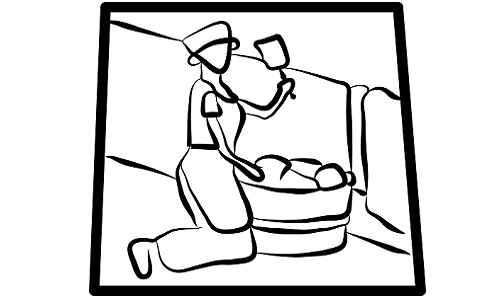Laundry Museum
Visiting the museum as a family can be a highly enriching experience for young and old alike! First and foremost, it's a chance for the generations to meet. Grandparents will be happy to talk about their lives to their children and grandchildren, who will then be in a better position to tell their family history.
The objects on display bring back a whole slice of life for the older generation. The objects bring back memories that are often very emotional. It's an opportunity for them to pass on elements of their family memory, and for younger people to discover a new facet of their parents or grandparents.
* By discovering how laundry was done before the invention of the washing machine, children will be able to better understand the technical aspects of a washing machine. A connection to running water, electricity to run the drum and heat the water, chemicals and electronics are all essential. The machine reflects the technical conditions available in a society. The object lives as if it were not situated in a more general context. Looking to the past allows us to question how it works.
* We can reflect on the lifestyles and values of people of different generations. Older people have lived in a world where technical goods were scarce, where people saved money and kept their appliances, machines and clothes as long as possible. Younger visitors will be able to compare this logic with their excessive consumption patterns in 2020 and the demands that global warming and the exploitation of the Earth will place on them.
*The visit will provide an opportunity to develop ideas on
- Hygiene and the fight against germs,
- environmental protection, with the need to use natural or plant-based soaps, and by offering activities on this theme for children. The brochure on soap plants is selling very well.
- Sustainable consumption, with reflections on programmed obsolescence and the life of our grandparents, based on saving resources and preventing waste.
* Welcoming a family also means welcoming children, allowing them to experiment and touch. That's why we've created a "laboratory" where children and adults can operate old washing machines.
* For younger visitors, we designed an 11-panel exhibition showing the different activities involved in washing clothes in 1950. We used drawings by Marc Renier integrated with documents from the period.
The objects on display bring back a whole slice of life for the older generation. The objects bring back memories that are often very emotional. It's an opportunity for them to pass on elements of their family memory, and for younger people to discover a new facet of their parents or grandparents.
* By discovering how laundry was done before the invention of the washing machine, children will be able to better understand the technical aspects of a washing machine. A connection to running water, electricity to run the drum and heat the water, chemicals and electronics are all essential. The machine reflects the technical conditions available in a society. The object lives as if it were not situated in a more general context. Looking to the past allows us to question how it works.
* We can reflect on the lifestyles and values of people of different generations. Older people have lived in a world where technical goods were scarce, where people saved money and kept their appliances, machines and clothes as long as possible. Younger visitors will be able to compare this logic with their excessive consumption patterns in 2020 and the demands that global warming and the exploitation of the Earth will place on them.
*The visit will provide an opportunity to develop ideas on
- Hygiene and the fight against germs,
- environmental protection, with the need to use natural or plant-based soaps, and by offering activities on this theme for children. The brochure on soap plants is selling very well.
- Sustainable consumption, with reflections on programmed obsolescence and the life of our grandparents, based on saving resources and preventing waste.
* Welcoming a family also means welcoming children, allowing them to experiment and touch. That's why we've created a "laboratory" where children and adults can operate old washing machines.
* For younger visitors, we designed an 11-panel exhibition showing the different activities involved in washing clothes in 1950. We used drawings by Marc Renier integrated with documents from the period.

Closed on 12/25/2025
- T. +32 495 27 46 71
- Rue Hanster 10 - 4900 Spa
- https://museedelalessivespa.be
- info@museedelalessivespa.be





